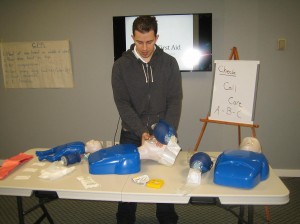Standard first aid courses are the most popular basic first aid courses offered by all 4 of the major Canadian providers. It is the longest and most comprehensive of all of the basic first aid courses. Students learn to treat and recognize a variety of different first aid emergencies and learn basic CPR skills for rescuing adults, children and infants. Over 50,000 people register every year for standard first aid courses in Canada.

Providers that offer Standard First Aid classes:
- St. Johns Ambulance
- St Mark James Training
- The Heart and Stroke Foundation of Canada
CPR Training:
CPR “C” training comes standard with this course, however, students have the option of selecting other levels of CPR to accompany the first aid course. The other level’s of CPR that can partner a standard first aid class are:
- CPR “A” – This level of CPR could possibly make the course shorter and cheaper. The CPR provided in this program teaches students CPR for adult and child victims.
- CPR “B” – This is a rare option as CPR “B” is being removed from most providers programs. This level of CPR was originally designed to teach students CPR for adult and child victims, however, this is now part of the CPR “A” program which has made level “B” obsolete.
- CPR “C” – This level comes standard with standard first aid. Students will learn basic CPR for rescuing adults, children and infants.
- Health Care Provider CPR (CPR “HCP”) – This is the most advanced level of CPR to accompany standard first aid. It usually costs candidates more for this option and the course can take an extra hour.
Automated External Defibrillator (AED) Training:
CPR combined with the use of AED’s has dramatically increased survival rates for victims in cardiac arrest. Because of the successes in the use of AED’s, AED training has become compulsory in all first aid and CPR courses. Standard first aid courses include training and certification in the use of AED’s.
Class Content:
Students enrolled in this course will learn the following skills and or knowledge:
- How to perform CPR for adults, children and infants.
- How to recognize and treat conscious and unconscious obstructed airway victims (choking).
- How to recognize and treat respiratory emergencies including asthma, hyperventilation, anaphylaxis (allergic reactions) and aspiration.
- Circulatory emergencies including heart attacks, angina, strokes and transient ischemic attacks (T.I.A’s)
- How to treat victims suffering with deadly bleeding and embedded objects.
- How to recognize and treat internal bleeding.
- How to recognize and treat 1st, 2nd and 3rd degree burns.
- How to treat fractures and broken bones.
- How to treat and recognize sprains and strains.
- How to respond to victims of environmental emergencies including hypothermia, heat exhaustion, heat cramps and heat stroke.
- How to recognize symptoms of and manage spinal injuries.
- How to treat victims of poisons.
- When and how to apply a automated external defibrillator (AED).
- How to recognize and treat seizures
- How to stay safe, be prepared and handle emergency situations.
Certification:
When candidates successfully complete the standard first aid course through the 4 major providers they will receive certification that meets legislative requirements. This certification will come in either a wallet sized card or a 8.5 by 11 inch wall mount certificate. The certificate is valid for 3 years but candidates may be required to re-certify the award at an earlier date based on employee or school policy.
Re-Certification:
St Mark James Training is one of the few national providers that offer standard first aid re-certification courses that are cheaper and shorter than the original course. Re-certification certificates are valid for 3 years and meet legislative standards.
Typical Candidates:
Candidates that take the standard first aid course come from a variety of different places. The following is a list of some of the candidates that may be required to take this course:
- Police Officers
- Firefighters
- Teachers
- Students
- Nursing Students
- Doctors
- Security workers
- Lifeguards
- Caregivers
- Parents
- Retail workers
- Healthcare workers
- Construction workers
- Childcare workers
- Fitness trainers
- Community center employee’s.
Course Fee:
The course fee for standard first aid training varies from 120 dollars to 165 dollars based on location, selected CPR option, taxes and provider.
Prerequisites:
Students must be at least 12 years of age to attend this course.
Homework or Pre-Class Assignments:
Candidates may be assigned pre-course assignments or homework during or prior to the course. Check with your provider or training partner to determine if any extra work is required.
Course Length:
Depending on the provider and instructor, standard first aid training ranges in length from 13.5 to 20 hours. This is the length of the course in class time which does not include breaks. Course length varies based on CPR option included in the course. CPR level “A” will likely be shorter and CPR “HCP” will likely be longer.
Course Locations:
The following is a list of standard first aid course locations throughout Canada. These are the top St Mark James providers in the mentioned municipality:
Standard First Aid Training in Vancouver, British Columbia
Standard First Aid Training in Calgary, Alberta
Standard First Aid Training in Edmonton, Alberta
Standard First Aid Training in Winnipeg, Manitoba
Standard First Aid Training in Saskatoon, Saskatchewan
Standard First Aid Training in Regina, Saskatchewan
Last update in standards:
The major 4 providers had completed an update in the standard first aid program in 2011. Update made revisions in CPR standards and included additional training in the first aid program.